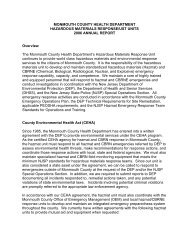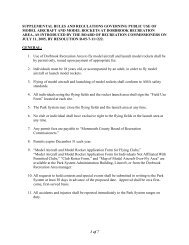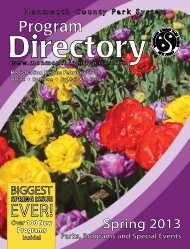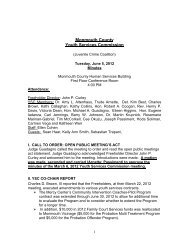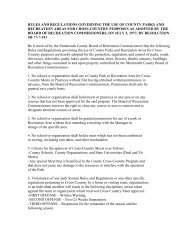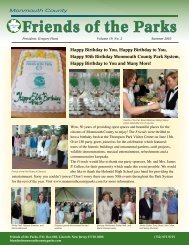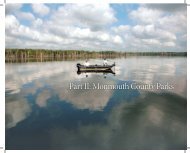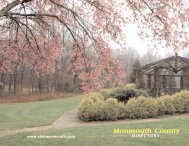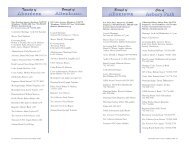Turtles of Monmouth County
Turtles of Monmouth County
Turtles of Monmouth County
- No tags were found...
You also want an ePaper? Increase the reach of your titles
YUMPU automatically turns print PDFs into web optimized ePapers that Google loves.
The <strong>Monmouth</strong> <strong>County</strong> Park System has two environmentalcenters dedicated to nature education.Each has a trained staff <strong>of</strong> naturalists to answervisitor questions and a variety <strong>of</strong> displays, exhibits,and hands-on activities where visitors <strong>of</strong> all agescan learn about area wildlife and natural history.The Huber Woods Environmental Center, onBrown’s Dock Road in the Locust Section <strong>of</strong>Middletown, features newly renovated exhibitsabout birds, plants, wildlife and the Lenape Indians.Miles <strong>of</strong> surrounding trails <strong>of</strong>fer many opportunitiesto enjoy and view nature.Nature Series<strong>Turtles</strong><strong>of</strong> <strong>Monmouth</strong> <strong>County</strong>Introduction<strong>Turtles</strong> are reptiles--kin to snakes, lizards, alligators, and crocodiles. However, they carry part <strong>of</strong>their skeleton on the outside <strong>of</strong> their bodies, which makes them unique from most other animals.Plus, with a lifespan <strong>of</strong> up to 80 years for some local species, they are very special indeed!Turtle Tales is a popular program <strong>of</strong>fered byPark System Naturalists-here a baby paintedturtle is displayed.As with other reptiles, turtles are ectothermic (also known as“cold-blooded”), which means they use their surroundingsto regulate body temperature. To cool <strong>of</strong>f, they burrow inthe mud or hide undervegetation. To warm up,they bask in the sun. Inwinter, all reptiles in ourarea must hibernate tosurvive the cold.Spend some time in the parks, especiallynear the water, and you will have to tryhard NOT to see Painted <strong>Turtles</strong>.The Manasquan Reservoir Environmental Center,on Georgia Tavern Road in Howell specializes inwetland species. The center has many waterrelateddisplays and exhibits to learn about localplants and wildlife. The 5-mile perimeter trail is agreat place to explore and enjoy nature.Threats to <strong>Turtles</strong>Road mortality is a threat to many localspecies. This threat occurs most <strong>of</strong>ten whenthe females are moving to and from theirbreeding sites. Other threats include habitatloss, habitat fragmentation (when breedingsites are separated from feeding sites, forexample) and illegal collection. In the case <strong>of</strong>the threatened Wood Turtle and endangeredWood TurtleBog Turtle, continued habitat destructionand collection could cause a local extinction(extirpation).Many people think it is OK to bring a foundturtle home as a pet. The best policy is toadmire turtles from a distance and leave themalone to enjoy their own natural habitat. <strong>Turtles</strong>remain much healthier if left in the wild.Bog Turtle<strong>Monmouth</strong> <strong>County</strong>Board <strong>of</strong> Chosen FreeholdersBoard <strong>of</strong> Recreation CommissionersA12066-03/12Painted <strong>Turtles</strong>www.monmouthcountyparks.com
Common <strong>Turtles</strong> <strong>of</strong><strong>Monmouth</strong> <strong>County</strong>Eastern Box Turtle (Special Concern)Common Snapping TurtleEastern Painted TurtleRed Bellied TurtleBog Turtle (Endangered)Spotted Turtle (Special Concern)Musk TurtleEastern Mud TurtleNorthern Diamondback Terrapin(Special Concern)Occasionally, turtles that are not native to thisarea are found in <strong>Monmouth</strong> <strong>County</strong>. This usuallyhappens when they are brought into the area aspets and released by their owners. This is a badpractice because it puts non-native turtles intocompetition with native turtles. Some non-nativeturtles that have been found here include theEastern Spiny S<strong>of</strong>tshell and the Red-eared Slider.Land <strong>Turtles</strong>There is really only one land turtle commonlyfound in <strong>Monmouth</strong> <strong>County</strong>, and that is theEastern Box Turtle. It is the only turtle in the areathat can close its shell like a box, hence its name.The color <strong>of</strong> its fully grown, 6 inch shell variesfrom black to brown with markings that rangefrom yellow to red-orange. This turtle eats mostlyworms, slugs, and insects, but will also eat fruits,vegetables, and mushrooms to supplement itsmeat diet.Water <strong>Turtles</strong>There are many water turtles native to<strong>Monmouth</strong> <strong>County</strong>. The one you are mostlikely to see is the Eastern Painted Turtle. Ithas a black shell edged in red and yellow,and can grow to a length <strong>of</strong> 6 inches. Paintedturtles are <strong>of</strong>ten seen resting on logs inponds and lakes. Even from a distance, theglint <strong>of</strong> the sun <strong>of</strong>f <strong>of</strong> its polished-lookingshell gives its presence away. Snails, insects,and fish are included in its diet. The largerbut similar looking Red-bellied Turtle isalso frequently sighted in our waterways,especially in larger and deeper lakes.The Snapping Turtle is another commonpond inhabitant. Its shell can grow to 18 1/2inches and the turtle can weigh up to 35pounds, making it the largest local turtle.Triangular points at the back end <strong>of</strong> its shelland extremely long “dragon-like” tail makeit easy to identify. Fish, frogs, tadpoles, andmost small animals within its reach becomea meal, including small ducks, mice, andeven small turtles!Snapping TurtleWood Turtle (Threatened)Spotted TurtleEastern Box TurtleTwo smaller Painted <strong>Turtles</strong> (left) and the larger Red-Bellied Turtle (right) climb on the same log.This large Snapping Turtledraws its head in.Diamondback TerrapinThe dragon-like tail <strong>of</strong> theSnapping Turtle.Other local water turtles- the Bog, Spotted,Musk, and Eastern Mud--are much moresecretive, and you are less likely to see them.Spotted <strong>Turtles</strong> are a species <strong>of</strong> Special Concern because,although threats exist, they have not yet been placed on theEndangered/Threatened List.The Diamondback Terrapin is an inhabitant <strong>of</strong> saltwatermarshes.Further Reading: Schwartz, Vicki, and Golden, David M. 2002. FieldGuide to Reptiles and Amphibians <strong>of</strong> New Jersey. New Jersey Division<strong>of</strong> Fish and Wildlife



